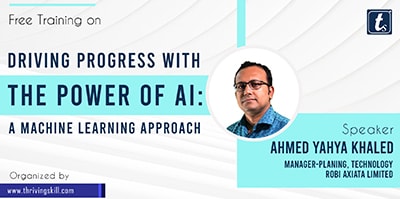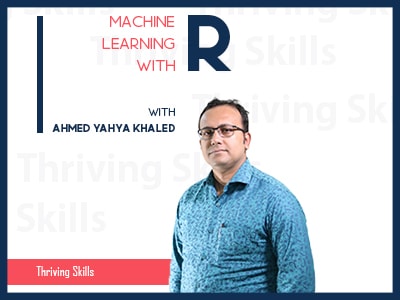Machine Learning with R
Course Description: Machine Learning (ML) is the subset of Artificial Intelligence (AI) which is one of the major pillars of the 4th Industrial Revolution(4IR). ML focuses on finding interpretable patterns and structures of data and enables us in learning, reasoning, and decision making in a fast and efficient way. “The world’s most valuable resource is no longer oil, but data”- The Economists. It is now obvious that to survive in this data-driven world every organization needs to have the right knowledge of leveraging data in the most effective way. Machine Learning model development is the first step to enter this …
Curriculum
Curriculum
- 10 Sections
- 130 Lessons
- 400 Days
- Module 1 : Machine Learning is the Future8
- 1.1Course Overview2 Minutes
- 1.2Overview Of 1st Module1 Minute
- 1.3Download documents1 Minute
- 1.4Introduction To Machine Learning2 Minutes
- 1.5Difference Between Traditional Programming & Machine Learning Programming4 Minutes
- 1.6Machine Learning & Artificial Intelligence9 Minutes
- 1.7Machine Learning Workflow6 Minutes
- 1.8Further Study1 Minute
- Module 2 : Introducing R and RStudio6
- Module 3 : Data Processing18
- 3.1R Overview Of Module 33 Minutes
- 3.2R Data-Types6 Minutes
- 3.3R Data-Structure3 Minutes
- 3.4Using String2 Minutes
- 3.5Using Matrix2 Minutes
- 3.6Data Transformation1 Minute
- 3.7Work with Data Set5 Minutes
- 3.8How to Filter Data10 Minutes
- 3.9Data Arrange2 Minutes
- 3.10Data Selection4 Minutes
- 3.11Using Mutate Function3 Minutes
- 3.12Using Gather Function6 Minutes
- 3.13Date & Time Data1 Minute
- 3.14Using Formula Of Date & Time7 Minutes
- 3.15Arrange Date & Time4 Minutes
- 3.16Finding Date & Time4 Minutes
- 3.17Missing Data4 Minutes
- 3.18Further Study1 Minute
- Module 4 : Data Visualization13
- 4.1Overview Of Module 41 Minute
- 4.2R Basic Plot And Lattice Plot6 Minutes
- 4.3Ggplot2 Scatter Plot6 Minutes
- 4.4Example of Scatter Plot3 Minutes
- 4.5Dividing Data in Different Plot3 Minutes
- 4.6Geom Smooth Function4 Minutes
- 4.7Drawing Line & Bar Plot8 Minutes
- 4.8Inserting Variables Into Bar Plot2 Minutes
- 4.9Drawing Stacked Bar Chart3 Minutes
- 4.10Box Plot4 Minutes
- 4.11Polar Transformation1 Minute
- 4.12Histogram2 Minutes
- 4.13Further Study1 Minute
- Module 5: Essential Statistics11
- 5.1Overview Of Module 51 Minute
- 5.2Central Tendency3 Minutes
- 5.3Working With Central Tendency3 Minutes
- 5.4Working With Central Tendency 23 Minutes
- 5.5Working With Central Tendency 31 Minute
- 5.6Normal Curves3 Minutes
- 5.7Outliers And Quartiles3 Minutes
- 5.8Outliers And Quartiles Execution1 Minute
- 5.9P-Value2 Minutes
- 5.10Confusion Matrix3 Minutes
- 5.11Further Study2 Minutes
- Module 6 : Regression Analysis18
- 6.1Linear Regression3 Minutes
- 6.2Solving Problem of Regression Analysis6 Minutes
- 6.3Randomly Data Divide4 Minutes
- 6.4Simple Linear Regression4 Minutes
- 6.5Multiple Linear Regression5 Minutes
- 6.6Data Prediction5 Minutes
- 6.7Support Vector Regression(SVR)2 Minutes
- 6.8Working With Support Vector Regression5 Minutes
- 6.9Decision Tree Regression3 Minutes
- 6.10Using Algorithm With Decision Tree Regression3 Minutes
- 6.11Decision Tree Visualization4 Minutes
- 6.12Random Forest Regression1 Minute
- 6.13Working With Random Forest Regression4 Minutes
- 6.14Predicted Value2 Minutes
- 6.15Model Comparison2 Minutes
- 6.16View Smooth Carve1 Minute
- 6.17Predicting From Production Curve6 Minutes
- 6.18Further Study2 Minutes
- Module 7 : Classification Analysis19
- 7.1Overview Module 72 Minutes
- 7.2Review Data2 Minutes
- 7.3Data Coveting3 Minutes
- 7.4Divided Datasets Into Training & Test Datasets5 Minutes
- 7.5Applying Formula of Logistic Regression5 Minutes
- 7.6K-Nearest Neighbors(K-Nn) Classification1 Minute
- 7.7Working With K-Nearest Neighbors(K-Nn) Classification7 Minutes
- 7.8Support Vector Machines (SVM)1 Minute
- 7.9Working with Support Vector Machines Classification3 Minutes
- 7.10Calculating Ypred Value3 Minutes
- 7.11Naive Bayes Classification1 Minute
- 7.12Working with Naive Bayes Classification3 Minutes
- 7.13Decision Tree Classification1 Minute
- 7.14Working with Decision Tree Classification4 Minutes
- 7.15Decision Tree Visualization2 Minutes
- 7.16Random Forest Classification1 Minute
- 7.17Working with Random Forest Classification4 Minutes
- 7.18Apply Modelin Production Data7 Minutes
- 7.19Further Study1 Minute
- Module 8 : Clustering Analysis11
- 8.1Overview of Module 83 Minutes
- 8.2Working with Clustering Analysis3 Minutes
- 8.3K-Means Clustering2 Minutes
- 8.4Applying K-Means Clustering3 Minutes
- 8.5Visualize Clustering3 Minutes
- 8.6K-Means Clustering Visualization7 Minutes
- 8.7Hierarchical Clustering1 Minute
- 8.8Working with Hierarchical Clustering4 Minutes
- 8.9Cutree4 Minutes
- 8.10Hierarchical Clustering Visualization4 Minutes
- 8.11Further Study1 Minute
- Module 9 : Association Rule Learning & Time Series Analysis11
- 9.1Overview of Module 92 Minutes
- 9.2Association Rule of Learning4 Minutes
- 9.3Apriori Algorithm4 Minutes
- 9.4Eclat Algorithm3 Minutes
- 9.5Time Series Analysis1 Minute
- 9.6Creating Time Series Data5 Minutes
- 9.7Time Series Decomposition5 Minutes
- 9.8Subtracting Time Series Elements3 Minutes
- 9.9Exponential Smoothing3 Minutes
- 9.10Auto Regressive Integrated Moving Average3 Minutes
- 9.11Further Study1 Minute
- Module 10 : Advanced Machine Learning15
- 10.1Overview of Module 102 Minutes
- 10.2Natural Language Processing4 Minutes
- 10.3Row Data To Corpus2 Minutes
- 10.4Bag of Words Model3 Minutes
- 10.5Dividing Data To Training & Test Sets-13 Minutes
- 10.6Random Forest Prediction5 Minutes
- 10.7Deep Learning (Artificial Neural Network)2 Minutes
- 10.8Datasets3 Minutes
- 10.9Data Conversion1 Minute
- 10.10Divide Data Set3 Minutes
- 10.11Using H2o Deep Learning Model 12 Minutes
- 10.12Using H2o Deep Learning Model 24 Minutes
- 10.13Calculating Ypred Value5 Minutes
- 10.14Further Study2 Minutes
- 10.15Conclusion3 Minutes
Overview
Course Description:
Machine Learning (ML) is the subset of Artificial Intelligence (AI) which is one of the major pillars of the 4th Industrial Revolution(4IR). ML focuses on finding interpretable patterns and structures of data and enables us in learning, reasoning, and decision making in a fast and efficient way.
“The world’s most valuable resource is no longer oil, but data”- The Economists. It is now obvious that to survive in this data-driven world every organization needs to have the right knowledge of leveraging data in the most effective way. Machine Learning model development is the first step to enter this domain of Artificial intelligence and Big data. ML has applications in all types of industries including telecommunication, manufacturing, retail, healthcare and life sciences, travel and hospitality, financial services, energy, and utilities.
This Machine Learning course will show hand-on program development in R. R is now a leading programming language for data analytics and ML. The course starts with an overview of ML, R, and Rstudio. It shows different data transformation and data visualization techniques to equip learners with expertise in data handling. Including essential statistics, this course covers two major topics of predictive analytics – Regression and Classification. With interesting exercises in R, you will be able to handle any strategic challenge of predicting future situations from previous data. This course also covers clustering analysis, Association Rule Learning, and Time Series analysis which will help organizations to find patterns from data and suggest customers/service segmentation, recommendation, and trend forecasting. In the last part, advanced machine learning techniques like NLP and Deep Learning will be covered.
Audience:
- All professionals willing to excel with the data-driven mindset
- Organizations trying to boost performance
- Strategic consultants
- Entrepreneurs
- Students preparing for an excellent career
Prerequisites:
There are no specified prerequisites for this course. Anyone having basic understandings of mathematics and statistics can complete this course to the end.
Why this Course?
With Hands-on R programming, this course covers all essential machine learning techniques with the most suitable way for all professionals. Exercise cases are carefully chosen so that learners can relate this to their work and bring excellence in their organizations. The main objective of this course is to equip business organizations in Bangladesh to become more competitive in the world.
Notes:
- Download the required documents from 1.3: Download documents
- After completing each lesson, you have to click on the “Complete” button to go to the next lesson.
- Must fill up your first name and last name for your certificate.
- Complete every lesson of this course serially.
- If you click on the “FINISH COURSE” button then the course will be finished, you will be unable to complete the next lessons or parts of this course, and a Certificate will be generated.
- When you click on the “RE-TAKE” button of the course profile, this course will start as a new course. You have to complete this from the first lesson to the last lesson.
Course Instructor
Course & Training of this Instructor:



